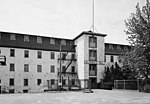Johnston, Rhode Island
Italian-American culture in Rhode IslandJohnston, Rhode IslandLittle Italys in the United StatesProvidence metropolitan areaTowns in Providence County, Rhode Island ... and 2 more
Towns in Rhode IslandUse mdy dates from July 2023

Johnston is a town in Providence County, Rhode Island, United States. The population was 29,568 at the 2020 census. Johnston is the site of the Clemence Irons House (1691), a stone-ender museum, and the only landfill in Rhode Island. Incorporated on March 6, 1759, Johnston was named for the colonial attorney general, Augustus Johnston.
Excerpt from the Wikipedia article Johnston, Rhode Island (License: CC BY-SA 3.0, Authors, Images).Johnston, Rhode Island
Adenauerring, Karlsruhe Innenstadt-Ost
Geographical coordinates (GPS) Address Website Nearby Places Show on map
Geographical coordinates (GPS)
| Latitude | Longitude |
|---|---|
| N 41.826666666667 ° | E -71.494722222222 ° |
Address
BBBank Wildpark
Adenauerring
76131 Karlsruhe, Innenstadt-Ost
Baden-Württemberg, Deutschland
Open on Google Maps







